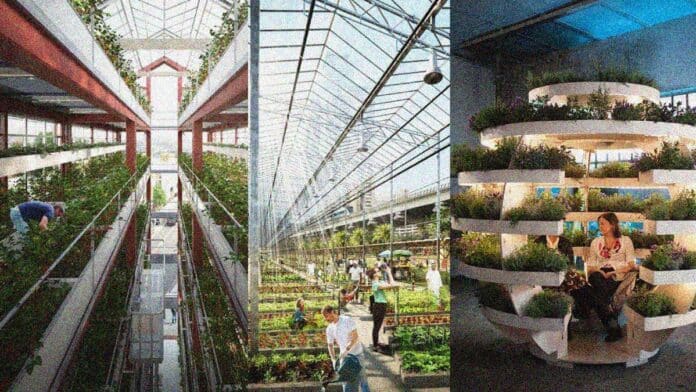As the world continues to grapple with issues such as climate change, food security, and rapid urbanization, a growing movement has emerged in cities worldwide: urban agriculture. Urban agriculture refers to the practice of cultivating, processing and distributing food within urban areas. It encompasses a wide range of activities, from community gardens and rooftop farms to vertical farming and aquaponics. This innovative approach to food production not only addresses the challenges posed by urban living but also offers a plethora of benefits for individuals, communities, and the environment. In this article, we will delve into the various facets of urban agriculture and explore its potential to transform our cities into sustainable and resilient spaces.
Contents
Rise of Urban Agriculture: An Answer to Urban Challenges
Urbanization and Food Security
Rapid urbanization has led to increased pressure on the global food system. Urban areas often struggle with limited access to fresh and nutritious food, resulting in food insecurity and health disparities. Urban agriculture provides a viable solution by bringing food production closer to the consumers. By cultivating food within the city, urban agriculture reduces reliance on long-distance transportation, ensuring a more secure and resilient food supply.
Environmental Concerns in Urban Areas
Cities are known for their concrete landscapes, but this urbanization comes at a cost to the environment. Urban agriculture offers an opportunity to mitigate some of these environmental concerns. By converting vacant lots, rooftops, and other underutilized spaces into green areas for cultivation, urban agriculture helps combat the urban heat island effect, reduces stormwater runoff, and improves air quality. It also contributes to carbon sequestration and promotes biodiversity by creating habitats for pollinators and other wildlife.
Reclaiming Vacant Spaces for Food Production
Abandoned or vacant lots are a common sight in many cities. Urban agriculture allows communities to reclaim and repurpose these spaces for productive use. Community gardens, for instance, transform derelict areas into vibrant green spaces where individuals and neighborhoods come together to grow their food. These initiatives not only beautify the urban landscape but also foster a sense of community, empowerment, and pride.
Types of Urban Agriculture
Community Gardens: Empowering Communities and Nurturing Bonds
Community gardens are perhaps the most recognizable form of urban agriculture. These shared spaces bring diverse groups of people together, fostering social connections and cultural exchange. Community gardens provide an opportunity for education, skill-building, and increased access to fresh produce, particularly in underserved neighborhoods.
Rooftop Farming: Harnessing Unused Space for Sustainable Cultivation
Rooftop farming has gained popularity in densely populated cities where land scarcity is a significant challenge. By utilizing the often unused rooftop spaces, urban dwellers can grow a variety of crops, including vegetables, herbs, and even small-scale livestock. Rooftop farms offer numerous advantages, such as improved insulation, reduced energy consumption, and reduced stormwater runoff.
Vertical Farming: High-Density Food Production in Skyscrapers
Vertical farming takes advantage of advanced technologies and vertical space within buildings to cultivate crops in stacked layers or towers. These controlled environment systems optimize the use of resources such as water, light, and nutrients, enabling year-round production of high-quality food. Vertical farming holds great potential for urban areas with limited available land, allowing for sustainable food production close to the consumer.
Hydroponics and Aquaponics: Innovative Soilless Techniques
Hydroponics and aquaponics are soilless cultivation methods that rely on nutrient-rich water solutions. Hydroponics involves growing plants directly in water, while aquaponics combines fish farming with hydroponics. These techniques require less water compared to traditional agriculture, eliminate the need for soil, and enable higher crop yields. They are particularly suitable for urban environments with limited space and can be integrated into various urban settings.
Benefits of Urban Agriculture
Improved Access to Fresh and Nutritious Food
One of the primary benefits of urban agriculture is improved access to fresh and nutritious food. By growing food locally, urban agriculture reduces the distance between production and consumption, ensuring that fruits, vegetables, and herbs are harvested at their peak freshness and nutritional value. This is especially significant in “food deserts” where access to healthy food options is limited. Urban agriculture initiatives, such as farmers’ markets and community-supported agriculture programs, bridge the gap by providing direct access to locally grown, seasonal produce.
Environmental Sustainability and Biodiversity Conservation
Urban agriculture plays a vital role in promoting environmental sustainability. Utilizing vacant lots, rooftops, and vertical spaces, maximizes land use efficiency and minimizes the need for deforestation and conversion of natural habitats. Moreover, urban agriculture reduces reliance on chemical pesticides and fertilizers, promoting organic farming practices that are beneficial for soil health and water quality. The integration of green spaces and vegetation in urban areas also enhances urban biodiversity by providing habitats for insects, birds, and other wildlife.
Community Engagement and Social Cohesion
Urban agriculture has the power to bring communities together, fostering social connections and strengthening bonds. Community gardens and urban farms serve as gathering places where people from diverse backgrounds come together to collaborate, share knowledge, and work towards a common goal. These spaces promote a sense of ownership, pride, and belonging, leading to increased social interaction and cooperation. In addition, urban agriculture projects often involve educational programs, workshops, and volunteer opportunities that empower individuals and create a sense of shared purpose.
Health and Well-being
The availability of fresh, locally grown food through urban agriculture positively impacts public health. Access to nutritious produce encourages healthier eating habits, reducing the prevalence of diet-related diseases such as obesity and diabetes. Engaging in gardening activities and spending time in green spaces has also been linked to improved mental health, stress reduction, and increased physical activity. Urban agriculture thus contributes to the overall well-being and quality of life of urban residents.
Job Creation and Economic Opportunities
Urban agriculture has the potential to generate employment opportunities and stimulate local economies. From farmers and gardeners to educators, food processors, and distributors, urban agriculture creates a range of jobs across the entire food value chain. Moreover, the production and sale of local food products contribute to the local economy, supporting small businesses and strengthening the resilience of urban communities.
Overcoming Challenges in Urban Agriculture
While urban agriculture holds great promise, it faces several challenges that need to be addressed for its widespread adoption and success.
Land Scarcity and Land-Use Conflicts
Urban areas are often characterized by limited available land, and competition for land use can pose a significant challenge for urban agriculture initiatives. Balancing the need for housing, infrastructure, and food production requires careful urban planning and policy interventions that prioritize and allocate space for urban agriculture. Land-use conflicts between different stakeholders must be addressed through community engagement, negotiations, and transparent decision-making processes.
Access to Resources: Water, Energy, and Inputs
Urban agriculture relies on access to essential resources, such as water and energy, which may be limited in densely populated cities. Innovative solutions, such as rainwater harvesting, drip irrigation, and energy-efficient technologies, can help mitigate resource constraints. Additionally, the availability of affordable and locally sourced inputs, such as seeds, fertilizers, and compost, is crucial for the viability and sustainability of urban agriculture projects.
Policy and Regulation
Clear and supportive policies are essential for the growth and development of urban agriculture. Governments at all levels need to recognize and integrate urban agriculture into urban planning frameworks, zoning regulations, and food policies. This includes providing incentives, removing barriers, and ensuring access to land for urban farming initiatives. Collaboration between policymakers, urban planners, and urban farmers is crucial to establish an enabling environment for urban agriculture.
Education and Skill Development
Education and awareness play a vital role in promoting urban agriculture. Providing training programs, workshops and educational resources for urban farmers and community members can enhance their knowledge and skills in sustainable farming practices, food preservation, and nutrition. By integrating urban agriculture into school curricula, educational institutions can contribute to building a future generation that understands the importance of food production, environmental stewardship, and healthy eating habits. Empowering individuals with the necessary skills and knowledge fosters the long-term sustainability and success of urban agriculture initiatives.
Successful Examples of Urban Agriculture
Several cities around the world have embraced urban agriculture and achieved remarkable success in implementing innovative projects:
Havana, Cuba: The Urban Agriculture Revolution
In response to economic challenges and limited access to imported food, Havana underwent a remarkable transformation through urban agriculture. With a focus on organic farming techniques and decentralized food production, the city now boasts an extensive network of urban farms, community gardens, and rooftop gardens. This urban agriculture revolution has not only increased food security but also improved community engagement and revitalized neighborhoods.
Detroit, USA: From Urban Decay to Urban Farms
Detroit, once known for its industrial decline and abandoned buildings, has become a hub for urban agriculture. The city has seen a surge in community gardens, urban farms, and food cooperatives, transforming vacant lots into productive spaces. These initiatives have not only provided fresh food to residents but have also contributed to economic revitalization, job creation, and community empowerment.
Singapore: Vertical Farming in the City-State
Facing limited land availability, Singapore has turned to vertical farming to enhance its food security. Through vertical farming techniques, such as hydroponics and indoor agriculture, the city-state produces a significant portion of its leafy vegetables locally. These vertical farms utilize innovative technologies and sustainable practices, reducing the reliance on imported produce and optimizing land use efficiency.
Future Prospects and Policy Implications
To fully unlock the potential of urban agriculture and integrate it into the fabric of our cities, certain key areas must be addressed:
Integration of Urban Agriculture in City Planning
Urban agriculture needs to be integrated into urban planning processes and frameworks from the outset. This involves recognizing and allocating suitable spaces for urban farming, designing green infrastructure, and incorporating food production into the development of new buildings and neighborhoods. By prioritizing urban agriculture as an integral part of city planning, we can create resilient and sustainable urban landscapes.
Collaboration between Governments, NGOs, and Businesses
The success of urban agriculture depends on collaborative efforts between various stakeholders. Governments, non-governmental organizations, businesses, and communities should work together to develop supportive policies, secure funding and resources, and establish partnerships that promote urban agriculture. Collaboration can help streamline regulations, share knowledge and best practices, and create a supportive ecosystem for urban farming initiatives to thrive.
Technology and Innovation in Urban Farming
Advancements in technology can significantly enhance the efficiency and productivity of urban agriculture. From automated vertical farming systems to data-driven resource management, technological innovations offer opportunities for optimizing resource use, monitoring plant health, and improving crop yields. Investing in research and development, as well as promoting the adoption of innovative technologies, can revolutionize urban agriculture and make it more scalable and economically viable.
Education and Awareness Programs
Promoting education and raising awareness about the benefits of urban agriculture is crucial for its long-term success. Educational institutions, community organizations, and governments should invest in programs that teach sustainable farming practices, nutrition, and the importance of local food systems. Building a knowledgeable and engaged community will foster a culture of urban agriculture and ensure its continued growth and resilience.
Conclusion
Urban agriculture has emerged as a transformative force that not only addresses the pressing challenges of urban living but also offers a multitude of benefits for individuals, communities, and the environment. By reclaiming vacant spaces, utilizing rooftops, and adopting innovative techniques like vertical farming, cities can foster local food production, improve food security, and reduce the ecological footprint associated with long-distance food transportation.
Furthermore, urban agriculture strengthens community bonds, enhances access to fresh and nutritious food, promotes biodiversity, and creates economic opportunities. However, to fully unlock the potential of urban agriculture, it is crucial to address challenges such as land scarcity, resource availability, and supportive policies. Through collaborative efforts and investments in technology and education, we can create sustainable, resilient, and inclusive cities that thrive on the integration of agriculture into urban landscapes.
By embracing urban agriculture, we pave the way for a greener future, where nature and human settlements coexist harmoniously, ensuring a better quality of life for present and future generations. Urban agriculture not only addresses the immediate needs of food security and environmental sustainability but also contributes to building resilient communities, promoting social cohesion, and fostering a sense of pride and empowerment. It offers a tangible solution to the multifaceted challenges of urbanization, climate change, and global food systems.
As more cities recognize the potential of urban agriculture and take proactive steps to integrate it into their urban fabric, we can witness a transformation in the way we produce, distribute, and consume food. Urban agriculture has the power to revolutionize our cities, making them more self-sufficient, sustainable, and livable. It is a holistic approach that not only nourishes our bodies but also nurtures our communities, restores the connection between people and nature, and redefines the relationship between urban spaces and food production.
In conclusion, urban agriculture is not just a trend; it is a fundamental shift in our approach to food and cities. It offers a pathway towards a more resilient, inclusive, and sustainable future. By leveraging innovative techniques, fostering collaboration, and empowering communities, we can harness the potential of urban agriculture to create thriving, green cities that are in harmony with nature. The time to embrace urban agriculture is now, and by doing so, we can cultivate a sustainable future in the concrete jungle.
Sources
- Despommier, D. (2010). The vertical farm: Feeding the world in the 21st century. Macmillan.
- Smit, J., Ratta, A., & Nasr, J. (2001). Urban agriculture: Food, jobs, and sustainable cities. United Nations Development Programme.
- Mougeot, L. J. (2005). Agropolis: The social, political, and environmental dimensions of urban agriculture. IDRC.
- Viljoen, A., & Bohn, K. (2005). CPULs: Continuous productive urban landscapes: Designing urban agriculture for sustainable cities. Architectural Press.
- Bakker, N., Dubbeling, M., Guendel, S., & Sabel-Koschella, U. (2000). Growing cities, growing food: Urban agriculture on the policy agenda. Urban Agriculture magazine, 1, 2-3.
- Cohen, N. (2006). The greening of the city: Urban agriculture for sustainable communities. Global urban development magazine, 2(1), 1-10.
- McClintock, Nathan, “Why Farm the City? Theorizing Urban Agriculture through a Lens of Metabolic Rift” (2010). Urban Studies and Planning Faculty Publications and Presentations. 91.
- Rosol, M., & Mireles, J. (2013). Urban agriculture: A guide to container gardens. University of Nevada Cooperative Extension.
- De Bon, H., Parrot, L., & Moustier, P. (2010). Sustainable urban agriculture in developing countries: A review. Agronomy for Sustainable Development, 30(1), 21-32.
- Guitart, D., Pickering, C., & Byrne, J. (2012). Past results and future directions in urban community gardens research. Urban Forestry & Urban Greening, 11(4), 364-373.
FACT CHECK: We strive for accuracy and fairness. But if you see something that doesn’t look right, please Contact us.
DISCLOSURE: This Article may contain affiliate links and Sponsored ads, to know more please read our Privacy Policy.
Stay Updated: Follow our WhatsApp Channel and Telegram Channel.













Great Article! It helped me to understand the sustanable future of agriculture.